Photographs: Gauri Nanada Ramesh Batlish, Centre Head, Guru Education Ltd
Engineering as a discipline has had a bull run year after year. The All India Engineering Entrance Examination (AIEEE) has had the highest number of examinees in a single-day competitive exam globally. The exam, which was scheduled for April 26, 2009, had 10 lakh students registered. This marked a record rise in the number from the previous year (8.26 lakh examinees had registered for 2008).
What is AIEEE?
The All India Engineering Entrance Examination is for all engineering aspirants who have appeared for or passed Class XII from any national or state recognised board. This exam is conducted for admission to the 20 National Institutes of Technology (NITs), four Indian Institutes of Information Technology (IIITs), Indian Institute of Information Technology and Management (IIITM), 16 self-financed deemed universities and nine other central and state government-funded institutions. The number of attempts for this exam is restricted to three.
Central counselling board for AIEEE: Admission Procedure
As per the direction of the Ministry of Human Resource Development (MHRD), 50 per cent of the seats in NITs will be filled from AIEEE eligible candidates of states where NITs are located and the other 50 per cent will be filled on an all-India merit basis. The MHRD will make efforts to establish NITs for those states/union territories that do not have NITs as of now.
In case the new NITs are not established before the start of admission based on AIEEE 2009, seats will be made available for the eligible students of such states/UTs which do not have any NIT, so as to keep the number of seats for such states/UTs at the level of 2007, after making due adjustment for the number of seats filled by eligible candidates of these states/ UTs. A list of the participating institutions will be furnished by Central Counselling Board 2009 at the appropriate time and will be available on the CCB website: www.ccb.nic.in.
Careers360, is a complete career magazine
Structure of the exam: Papers I and II
Image: A step-by-step guide to problem solvingAspirants have the choice of appearing for any one of the two types of papers or both. Paper I is for those who wish to opt only for BE/BTech courses in colleges accepting AIEEE ranks while Paper II is for those who wish to pursue a course in BArch/ BPlanning.
Paper I: This is a three-hour paper comprising three sections: Physics, Chemistry and Mathematics.
There are 30 questions in each of the three subjects. The questions are of objective type ie multiple-choice questions with a single correct answer. In each section there are 26 questions of four marks each and four questions of eight marks each. One must be very careful while answering as there is 1/4th negative marking for every question.
Paper II: This three-hour paper consists of Mathematics, Aptitude and Drawing.
The Mathematics section has 35-40 objective type multiple-choice questions with a single correct option and 1/4th negative marking. In this part, the syllabus for Mathematics comprises common topics from Class XI/ XII, CBSE/State board.
The Aptitude section has 10-15 objective multiple-choice questions with four options and 1/4th negative marking. This will test a student on visualising three-dimensional objects from two-dimensional drawings, visualising different sides of three-dimensional objects and also analytical reasoning and mental ability. The Aptitude Test is designed to evaluate a candidate's perception, imagination, observation, creativity and architectural awareness.
The Drawing section has two questions for 40 marks involving sketching of scenes and activities from memory of urbanscape (public space, market, festivals, street scenes, monuments, recreational spaces etc), landscape (river fronts, jungles, gardens, trees, plants etc) and rural life.
Subjects and level of difficulty
Image: A list of the National Institutes of TechnologyClearing AIEEE is not a difficult task. A systematic approach towards its preparation will help students get admission into one of the top National Institutes of Technology (NITs). AIEEE consists of CBSE syllabus of Physics, Chemistry and Mathematics and some common topics from Class XI and XII of state boards. In AIEEE 2009, Mathematics and Physics were definitely difficult as compared to the previous year. Chemistry was relatively simple. About 25 per cent questions in the paper are easy, 50 per cent are average and 25 per cent difficult. The cut-off for AIEEE is generally between 60 to 70 per cent.
How to prepare for AIEEE
Two years of planned, organised preparation for AIEEE is all that is required. Appropriate study material is the first thing an aspirant must have. Every set of problems needs to be approached differently and with a separate methodology.
Regular practice makes a student confident to tackle the problems. Speed and accuracy is the key to success.
Relevant study material
Books are preferred for shaping your conceptual understanding. There is a plethora of problem-solving books. It will do a student good to solve other competitive examination problems. Practise a lot.
Success tips for the exam
Image: A list of the Self-Financed/ Deemed universities- Speed and accuracy is an important aspect, which comes from extensive practice of similar questions.
- Always exercise time pressure while solving AIEEE papers. In Maths use short methods for calculations, skip irrelevant steps to save time.
- The most important thing is clarity of concepts and regular practice in problemsolving.
- AIEEE is not difficult, but tricky. However, its questions do have a need of being tackled with different tactics and perspectives.
- Focus on solving the problems on your own, while preparing for the exam.
- Both speed and strike rate matter. You need to be quick and accurate to achieve high scores. High speed with less accuracy can actually ruin your results.
- Never use a calculator while preparing for the AIEEE. Being adept at mental calculations can actually increase your speed to a great extent.
- Select your questions wisely. If you solve easy and average questions correctly, you can easily get through. You may attempt difficult ones to make merit.
- Gather and implement tips, gain confidence, be positive, and you will ace AIEEE.
Last lap before the AIEEE
Image: A list of the Inidan Institutes of Information TechnologyIn the last two weeks before AIEEE, aspirants must revise all the formulae and the important points during these two weeks. One must study all three subjects each day.
Must do in the last two weeks
- Make a note of important points.
- Make a timetable for the coming 12 days to revise your syllabus. A time-table must be developed in such a way that you give maximum time to your strengths. For instance, if you are strong in Electrostatics in Physics, then revise electrostatics, devoting enough time to it so that you are sure and confident of every concept in it. If you are not thorough in Modern Physics, then only revise the topics you have studied. Do not study anything new in the last week.
- Cover your syllabus during the next seven days. Now revise your complete syllabus once.
- Take a few Mock Tests to check your speed and accuracy.
- Identify the gaps or problem areas where you are wasting the maximum time. Whatever mistakes you make in the first paper try to rectify in the second. In this way you will be better prepared for the main exam. What most students do is that they revise the entire syllabus but never attempt a mock test. Therefore they make mistakes in the main exam and thus lose the race.
Day before
- Let your hair down the day before AIEEE. Do not study anything. Simply relax and indulge yourself.
- Stay calm, confident and trust your ability.
- Say to yourself 'I am excited about AIEEE and I can crack it'.
- Don't ask your friends how much they have studied. It will only create stress.
- Have a sound sleep for at least six to seven hours.
- Prepare to reach the exam centre an hour before the commencement of the exam.
Analysis of AIEEE 2008
Image: States/ Union Territories likely to use AIEEE09 scoresIf you closely study the AIEEE 2008 paper you will find that there were 105 questions each carrying three marks. The total marks were 315 out of which if you had scored 180+ marks you were safe to get a good college. On analysing last year's paper it was found that in physics most of the questions were from electricity, magnetism, modern physics and mechanics. These topics comprised about 75 per cent to 80 per cent of the paper. About 35 per cent of the questions were easy and 60 per cent were neither too difficult nor too easy. Chemistry is the broadest branch and one that is most scoring. An analysis of last year's paper revealed that physical chemistry had 12 questions, organic chemistry 12 and inorganic chemistry 11.
What this shows is that physical, organic and inorganic chemistry are given equal weight in AIEEE.
Now the part which the students say is difficult -- mathematics. Post the analysis it was found that chapters from Calculus and algebra are the most repeated in the previous year papers of AIEEE. In AIEEE 2008, 24 questions were there from these two topics alone.
Analysis of AIEEE 2009
Image: Other Central Government/ State Government funded institutionsIn AIEEE 2009 there was a marked change is the pattern of questions and marking scheme. The number of questions in each section was reduced to 30 but students found it tough as there were 24 questions of four marks and six questions of eight marks in each section along with 1/4th negative marking.
The eight-mark questions were time consuming and this was one reason why some students could not attempt many questions. In physics it was found that 40 per cent of the questions were easy, 52 per cent medium level and eight per cent difficult. More weight was given to chapters like heat and thermodynamics -- 17 per cent, optics -- 10 per cent, modern physics -- 10 per cent, electronics and communication -- 7 per cent and properties of matter -- 3 per cent.
In mathematics, 32 per cent of the questions were easy, 58 per cent average level of difficulty and 10 per cent difficult. More weight was given to chapters like coordinate geometry -- 13 per cent, integral Calculus -- 10 per cent, vector -- 3, dimensional geometry and determinants -- 10 per cent and trigonometry -- 3 per cent.
In chemistry, 40 per cent of the questions were easy, 50 per cent had a medium level of difficulty and 10 per cent were difficult. A 40 per cent weight was given to physical chemistry and 27 per cent to inorganic chemistry.
After going through the new marking scheme and level of difficulty of the papers we could conclude that if a student secured more that 225 out of 432 s/he could be sure of getting into one of the 20 NITs.
The importance of chemistry
Image: Cracking AIEEE 2010Importance of chemistry
It is observed that those who crack AIEEE are the ones who do well in chemistry. A week before the exam dedicate four hours to brush up your concepts of chemistry -- three hours for organic and inorganic chemistry and one hour for physical chemistry. Try to attempt chemistry in the first hour as it has some easy questions and if you can solve these questions in the first hour, you will feel confident. It has been proved that if you are confident, your efficiency increases. Inorganic and organic also cover a substantial portion in AIEEE. Chemistry is the most scoring subject.
Just read the concepts of thermodynamics and chemical equilibrium. Some questions from these parts are purely conceptual. So clear your concepts and you can successfully attempt 40 per cent questions from these two topics.
Expert advice / recommendation
Always attempt theoretical questions first and then questions which require calculation. It's human nature that if you attempt a few questions that build your confidence in the beginning then you feel loaded with positive energy which increases your efficiency and speed for the rest of the paper.

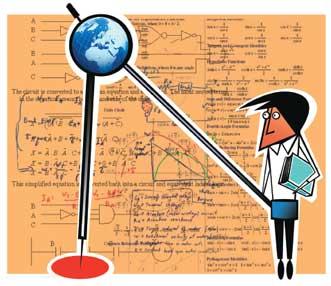
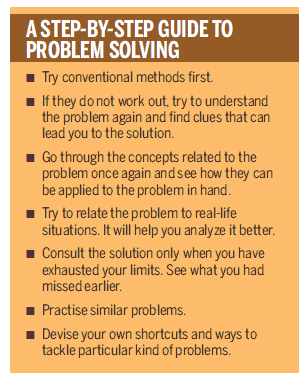

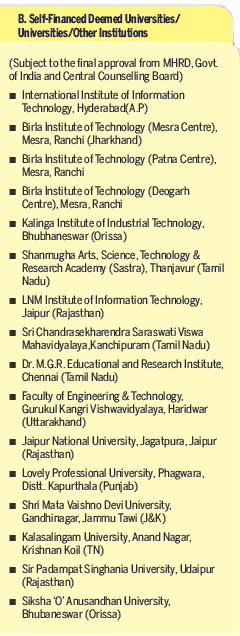
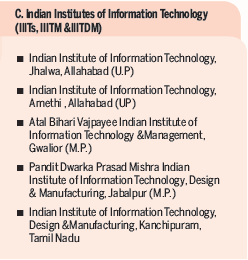

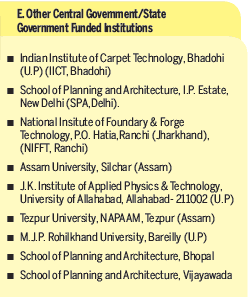
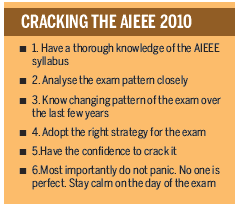
Comment
article